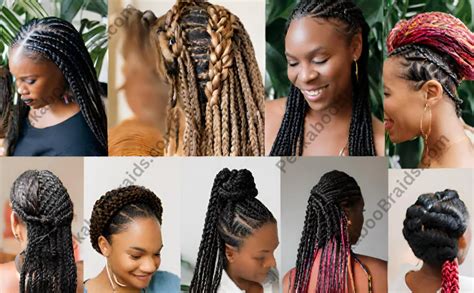Introduction: The Allure of Ombre Braiding
Ombre braiding has become a popular hairstyle choice due to its versatility, low maintenance, and ability to enhance natural hair texture. The ombre effect, characterized by a gradual transition from one color to another, adds depth and dimension to braids. This guide will explore 101 ombre braiding styles, providing step-by-step instructions, highlighting benefits, addressing pain points, and comparing pros and cons.

Benefits of Ombre Braiding
- Enhances Hair Texture: Ombre braiding can add volume and definition to thin or flat hair.
- Low Maintenance: Unlike traditional hair dyes, ombre braiding does not require regular touch-ups as the root growth blends seamlessly into the ombre effect.
- Protects Hair: When done correctly, ombre braiding can protect hair from heat, breakage, and environmental damage.
- Versatile Styling Options: Ombre braids can be styled in various ways, such as buns, ponytails, and updos, making them suitable for different occasions.
Addressing Pain Points
- Scalp Sensitivity: Some individuals may experience scalp sensitivity due to the tightness of the braiding.
- Potential Hair Breakage: If not done professionally or with proper care, ombre braiding can put stress on hair roots, leading to breakage.
- Time-Consuming: Ombre braiding can be a time-consuming process, especially on thick or long hair.
101 Ombre Braiding Styles
Full-Length Ombre Braids:
* Classic Ombre Braids: A gradual transition from dark roots to light ends, creating a natural-looking ombre effect.
* Reversed Ombre Braids: Dark ends fading into lighter roots, resulting in a unique and eye-catching style.
Mid-Length Ombre Braids:
* Dip-Dye Ombre Braids: A bold and trendy look where the tips of the hair are dyed in a bright or vibrant color.
* Layered Ombre Braids: Braids with multiple layers of ombre shades, adding depth and dimension to the hair.
Short Ombre Braids:
* Pixie Ombre Braids: Ombre braids on short pixie cuts, creating a sassy and edgy style.
* Bob Ombre Braids: A stylish option for bob haircuts, adding color and interest without overpowering the length.
Cultural Significance and Inspirations
Ombre braiding has its roots in various cultures around the world. The Zulu people of South Africa have traditionally used ombre braiding to indicate social status and age, while the Maasai women of East Africa use it as a form of self-expression and beautification.
Contemporary Inspirations:
* Celebrity Styles: Ombre braiding has gained popularity due to its adoption by celebrities, such as Beyoncé, Rihanna, and Khloé Kardashian.
* Social Media Trends: The ombre braiding trend has been amplified by social media platforms like Instagram and Pinterest, where users share countless variations of the style.
How to: Step-by-Step Ombre Braiding
Materials:
* Hair extensions
* Hair dye
* Hair bleach (optional)
* Comb
* Scissors
* Braiding needle (optional)
Instructions:
- Prepare the Hair: If necessary, bleach the hair to achieve the desired lightness.
- Create the Ombre Effect: Apply hair dye to the ends of the hair using a brush or sponge. Blend the colors to create a gradual transition.
- Wait and Rinse: Leave the hair dye on for the recommended time, then rinse thoroughly.
- Section the Hair: Divide the hair into multiple sections, depending on the desired braid style.
- Start Braiding: Create braids using the sections, starting from the roots and working towards the ends.
- Secure the Ends: Tie off or wrap the ends of the braids to secure them.
Pros and Cons of Ombre Braiding
Pros:
- Low maintenance
- Protects hair
- Enhances hair texture
- Versatile styling options
Cons:
- Scalp sensitivity
- Potential hair breakage
- Time-consuming
Table 1: Braiding Techniques
| Technique | Description |
|---|---|
| Three-Strand Braiding | Classic braiding technique using three strands of hair |
| Five-Strand Braiding | More complex technique creating intricate and decorative braids |
| Fishtail Braiding | Unique braiding style resembling a fishtail |
| Waterfall Braiding | Half-up, half-down braid that flows like a waterfall |
Table 2: Pain Management Strategies
| Strategy | Description |
|---|---|
| Braid Loosely | Avoid braiding too tightly to prevent scalp sensitivity |
| Use Graduated Tension | Gradually tighten the braid as you move towards the ends, reducing pressure on the scalp |
| Apply Scalp Oil | Massage scalp oil into the scalp before braiding to soothe and protect it |
| Take Breaks | If experiencing discomfort, pause braiding and allow the scalp to rest |
Table 3: Styling Inspiration
| Hairstyle | Description |
|---|---|
| Ombre Ponytail | High or low ponytail with ombre braids |
| Ombre Updo | Elegant updo featuring ombre braids |
| Ombre Crown Braid | Braided crown around the head with ombre colors |
| Ombre Cornrows | Traditional cornrows with ombre shading |
Table 4: Maintenance Tips
| Tip | Description |
|---|---|
| Detangle Regularly | Brush or comb the braids regularly to prevent tangles |
| Moisturize Hair | Apply hair oil or cream to keep the braids hydrated |
| Cover At Night | Wear a satin sleeping cap or scarf to protect braids from friction |
| Remove Braids Regularly | Avoid keeping braids in for extended periods to prevent hair damage |
Conclusion
Ombre braiding offers a wide range of styles, benefits, and inspirations. By following the step-by-step instructions, addressing pain points, and understanding the pros and cons, individuals can create stunning ombre braided hairstyles that enhance their natural beauty and reflect their individual style. The versatility and low-maintenance nature of ombre braiding make it an ideal choice for those seeking a trendy and protective hairstyle.
